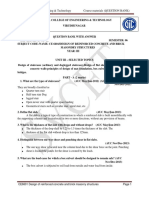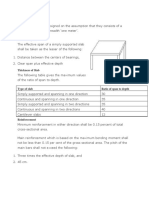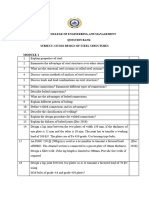Unit IV - Limit State Design of Columns
Unit IV - Limit State Design of Columns
Uploaded by
ManikandanCopyright:
Available Formats
Unit IV - Limit State Design of Columns
Unit IV - Limit State Design of Columns
Uploaded by
ManikandanCopyright
Available Formats
Share this document
Did you find this document useful?
Is this content inappropriate?
Copyright:
Available Formats
Unit IV - Limit State Design of Columns
Unit IV - Limit State Design of Columns
Uploaded by
ManikandanCopyright:
Available Formats
CE6505 DESIGN OF REINFORCED CONCRETE ELEMENTS
UNIT IV
LIMIT STATE DESIGN OF COLUMNS
Types of columns
Braced and unbraced columns
Design of short Rectangular and circular columns for axial, uniaxial and biaxial bending
Compiled by: Mr. S. MANIKANDAN, Assistant Professor, Department of Civil Engineering, Shanmuganathan Engineering College.
CE6505 DESIGN OF REINFORCED CONCRETE ELEMENTS
2 Marks [Questions & Answers]
01) What is pedestal?
Ans.: A very short column having the ratio of effective length (leff) to least lateral dimension (b or B)
as less than there is called pedestal.
It is also called stub column. It is generally of plain concrete. i.e. un-reinforced.
02) On what condition intermediate column is more suitable?
Ans.: The intermediate column is more suitable, when the slenderness ratio more than three and less
than or equal to 12 (3 < leff/d < 12). It is also known as Short column.
03) Differentiate long column and short column.
Ans.:
Long column
Short Column
A Column having the ratio of effective A Column having the ratio of effective length
length (leff) to least lateral dimension (b or d) (leff) to least lateral dimension (b or d) as less
as more than 12.
than or equal to 12.
The failure pattern of long Column is The failure pattern of short column is
Buckling.
Crushing.
04) What are braced column?
Ans.: A braced column is one which the side sway is insignificant, i.e., there is no significant relative
displacement between the two ends of the column in the direction under consideration; such columns
do not resist any significant horizontal load like wind or earthquake loads.
Examples: Columns of water towers with bracings at different heights and columns in tall
buildings provided with shear walls.
05) Distinguish between braced and unbraced columns.
Ans.:
Braced column
Un-braced Column
In Braced Columns, the side sway is In Un-braced Columns, there is significant
insignificant.
lateral displacement between the ends.
It does not resist any significant horizontal It resists lateral loads in addition to vertical
loads like wind and earthquake loads.
S.M.K./A.P./CIVIL/S.E.C.
loads.
UNIT IV LIMIT STATE DESIGN OF COLUMNS
06) Enumerate axially loaded column.
Ans.: The column which carries a purely axial load is termed as axially loaded column.
It is also called concentrically loaded column.
07) What are the types of reinforcements used to resist shear force in columns?
Ans.: There are two types of reinforcements used to resist shear force in columns. Such as
1. Lateral ties for Rectangular columns.
2. Helical reinforcements for Spiral columns.
08) What are the advantages of providing helical reinforcement instead of lateral ties in a
circular column?
Ans.: The following are the advantages for providing helical reinforcements instead of ties.
(i) Spiral column failed gradually.
(ii) It exhibiting considerable amount of ductility and deformation.
(iii) There will be a lot of warning before final failure.
09) Write any two support conditions of columns.
Ans.: The following are the list of support conditions of columns:
(i) End rotation unrestrained
(ii) End rotations restrained
(iii) One end restrained other unrestrained
(iv) Both ends partially restrained
(v) End rotations restrained
(vi) One end rotation restrained other end unrestrained
(vii) One end rotation partially restrained, other end unrestrained
(viii) Partially restrained at both ends
10) Write down the expression for minimum eccentricity?
Ans.: As per clause 25.4 of IS 456: 2000, the minimum eccentricity equal to the unsupported length
(l) / 500 plus lateral dimension (b and D) / 30.
L
e (min)
b
+
500
L
and
30
e (min)
D
+
500
30
TWO MARK Q & A and BIG QUESTIONS
CE6505 DESIGN OF REINFORCED CONCRETE ELEMENTS
11) According to IS code, all columns shall be designed for minimum eccentricity. Justify the
reasons for this statement.
Ans.: According to IS code, all columns shall be designed for minimum eccentricity. Because to
avoid the imperfections in constructions, inaccuracy in loading etc.
12) What is the formula used in the Bresler's Load contour method of approach for short
columns subjected to axial load and biaxial bending?
Ans.: IS 456: 2000 (clause 39.6) has recommended the formula proposed by Bresler for the design of
columns subjected to biaxial bending. The method is based on interaction surface for the load system
Pu, Mux and Muy.
Mux
Muy
+
Mux1
< 1.0
Muy1
Where Mux1 and Muy1 are the uniaxial moment capacities combining the given axial load Pu with
bending moments about x and y axes, respectively.
13) On what condition long column is more suitable?
Ans.: A long column is susceptible to buckling. i.e. its load carrying capacity is influenced by the
slenderness effect which produces additional moments resulting from transverse deformation.
14) Name any two methods used for design of long columns.
Ans.: The following are the methods used for design of long columns:
(i) The strength reduction coefficient method
(ii) The additional method
(iii) The moment magnification method
15) Define overturning on columns.
Ans.: The unbalanced moments tends to topple the columns, this effects is called as overturning on
columns.
S.M.K./A.P./CIVIL/S.E.C.
UNIT IV LIMIT STATE DESIGN OF COLUMNS
16 Mark [Questions]
CE2306 (R 2008) - April / May 2015 (A.U. Chennai) Q.P. Code: 71258
(Or)
CE2306 (R 2008) November / December 2014 (A.U. Chennai) Q.P. Code: 91243
(Or)
CE2306 (R 2008) May / June 2014 (A.U. Chennai) Q.P. Code: 51242
(Or)
TWO MARK Q & A and BIG QUESTIONS
CE6505 DESIGN OF REINFORCED CONCRETE ELEMENTS
CE2306 (R 2008) November / December 2013 (A.U. Chennai) Q.P. Code: 31210
(Or)
CE2306 (R 2008) - May / June 2013 (A.U. Chennai) Q.P. Code: 21210
(a) Design a column 4 m long restrained in position and direction at both ends to carry an axial
load of 1600 kN. Use M 20 concrete and Fe 415 steel.
(16)
(Or)
(b) Design a column size 450 mm X 300 mm. Use M 30 concrete and Fe 415 steel. Take
Lex = 6 m, Ley = 5.5 m, Pu = 1600 kN, Mux = 45 kN-m at top and 40 kN-m at bottom.
Muy = 40 kN-m at top and 25 kN-m at bottom. The column is bent in double curvature and
assumes a cover of 50 mm.
(16)
CE2306 (R 2008) November / December 2012 (A.U. Chennai) Q.P. Code: 11194
(Or)
CE2306 (R 2008) - May / June 2012 (A.U. Chennai) Q.P. Code: 10229
S.M.K./A.P./CIVIL/S.E.C.
UNIT IV LIMIT STATE DESIGN OF COLUMNS
(Or)
CE1354 (R 2004) - April / May 2011 (A.U. Chennai) Q.P. Code: 55232
(Or)
Compiled By:
Mr. S. MANIKANDAN M.E. (Structural Engg.)
Assistant Professor,
Department of Civil Engineering,
Shanmuganathan Engineering College,
Arasampatti, Pudukkottai 622507.
Email: smanikandanme@gmail.com
TWO MARK Q & A and BIG QUESTIONS
You might also like
- Geotech Interview QuestionsDocument27 pagesGeotech Interview Questionskhyrul fasilNo ratings yet
- Grade 6 T.L.EDocument4 pagesGrade 6 T.L.EAgyao Yam Faith100% (18)
- Nov - Dec 2020 X86202 (ST5204)Document4 pagesNov - Dec 2020 X86202 (ST5204)Karthik PandiNo ratings yet
- Assignment No 2Document13 pagesAssignment No 2danish malikNo ratings yet
- Cece 4244 - Advanced RC DesignDocument195 pagesCece 4244 - Advanced RC DesignJaya RamNo ratings yet
- System Identification Using MATLABDocument37 pagesSystem Identification Using MATLABMarwan Elmahdi90% (10)
- Unit 5Document42 pagesUnit 5ashok Pradhan0% (1)
- Unit III - Limit State Design For Bond, Anchorage Shear & TorsionDocument8 pagesUnit III - Limit State Design For Bond, Anchorage Shear & TorsionManikandan0% (1)
- Unit 3Document29 pagesUnit 3ashok Pradhan100% (1)
- QB 103613Document23 pagesQB 103613Sumit RaghuvanshiNo ratings yet
- Design of SlabDocument4 pagesDesign of SlabCharan ReddyNo ratings yet
- Ce Foundation EngineeringDocument40 pagesCe Foundation EngineeringSasi HoneyNo ratings yet
- Dss Question Bank 2022Document7 pagesDss Question Bank 2022vcb57xbtd5No ratings yet
- Internship Report On Study of Construction of AuditoriumDocument65 pagesInternship Report On Study of Construction of AuditoriumadityaNo ratings yet
- Internship SohanDocument33 pagesInternship SohansohanpmeharwadeNo ratings yet
- Chapter - 1 in Elastic Moment RedistributionDocument8 pagesChapter - 1 in Elastic Moment RedistributionHelen NegashNo ratings yet
- CE2306 Design of RC Elements Anna University Question Bank Question Paper 2 Marks and 16 MarksDocument9 pagesCE2306 Design of RC Elements Anna University Question Bank Question Paper 2 Marks and 16 MarksrexdindigulNo ratings yet
- RCC Question BankDocument3 pagesRCC Question BankPurab PatelNo ratings yet
- CE F417-Applications of AI in Civil Engineering-JagadeeshDocument3 pagesCE F417-Applications of AI in Civil Engineering-JagadeeshMasina Sai SatishNo ratings yet
- Prefaricated Structures Unit IIIDocument53 pagesPrefaricated Structures Unit IIIvgshankar26100% (1)
- Introduction Slope StabilityDocument52 pagesIntroduction Slope StabilityvishwaskhatriNo ratings yet
- PPTDocument23 pagesPPTVishnu Vardhan MekalaNo ratings yet
- MCQ Compression With AnswerDocument8 pagesMCQ Compression With Answerutsav_koshtiNo ratings yet
- Methods of Analysis of Prestressed Continuous Beam: /contdDocument26 pagesMethods of Analysis of Prestressed Continuous Beam: /contdAdam SalimiNo ratings yet
- DSR Unit 1Document69 pagesDSR Unit 1hujefaNo ratings yet
- Well Foundation-IOE QuestionsDocument1 pageWell Foundation-IOE QuestionsRajesh Khadka0% (1)
- SSC Je Concrete Technology NotesDocument20 pagesSSC Je Concrete Technology NotesMohammad saifNo ratings yet
- Basic Question For Intern Students - 2Document2 pagesBasic Question For Intern Students - 2Thomas MehariNo ratings yet
- Combined Footing Vtu DocumentDocument22 pagesCombined Footing Vtu DocumentSyed IsmailNo ratings yet
- Seismic Behaviour of RCC Shear Wall Under Different Soil ConditionsDocument4 pagesSeismic Behaviour of RCC Shear Wall Under Different Soil Conditionsdurga mibangNo ratings yet
- Design Concept of SubstructureDocument19 pagesDesign Concept of SubstructureMaithri R HebbarNo ratings yet
- Department of Civil Engineering Subject Name: Basic Civil Engineering Question Bank Unit 1 Part I - 2 Marks QuestionsDocument7 pagesDepartment of Civil Engineering Subject Name: Basic Civil Engineering Question Bank Unit 1 Part I - 2 Marks QuestionsM.suresh SureshNo ratings yet
- GEOTECHNICAL ENGINEERING - SyllabusDocument9 pagesGEOTECHNICAL ENGINEERING - SyllabusHarikrishna SNo ratings yet
- Unit-I - Limit State Method Concept and Design of Beams: 1. MaterialsDocument7 pagesUnit-I - Limit State Method Concept and Design of Beams: 1. MaterialsYAZHININo ratings yet
- Advanced Earthquake Resisting TechniquesDocument14 pagesAdvanced Earthquake Resisting TechniquesPrashant SunagarNo ratings yet
- Intenship ReportDocument17 pagesIntenship ReportYdv DeepNo ratings yet
- Concrete Paving TechnologyDocument25 pagesConcrete Paving TechnologySagar BhardwajNo ratings yet
- Problem 1: Determine The Horizontal Displacement and Rotation of The Frame Shown Below at Support DDocument16 pagesProblem 1: Determine The Horizontal Displacement and Rotation of The Frame Shown Below at Support Dkurou hazamaNo ratings yet
- Abstract UneditedDocument7 pagesAbstract UneditedRavi Teja SrikaramNo ratings yet
- DRC Important QuestionsDocument11 pagesDRC Important QuestionsAdithya31No ratings yet
- Unit 2.1Document40 pagesUnit 2.1naren0143No ratings yet
- Design Procedure of Reinforced Concrete T BeamDocument11 pagesDesign Procedure of Reinforced Concrete T BeamkhbaltazarrNo ratings yet
- CEN-665 ETE Solution Spring 2021-22Document3 pagesCEN-665 ETE Solution Spring 2021-22JAYA RAWATNo ratings yet
- Design of ColumnsDocument26 pagesDesign of ColumnsMandar NadgaundiNo ratings yet
- Advantages of PrestressedDocument3 pagesAdvantages of PrestressedLarete PaoloNo ratings yet
- Course FileDocument23 pagesCourse Fileroopa saravananNo ratings yet
- Is 456 2000 Most Expected Questions (Avnish Sir) 30-03-22Document35 pagesIs 456 2000 Most Expected Questions (Avnish Sir) 30-03-22Satypal NishadNo ratings yet
- Concrete Structures Model Question PapersDocument2 pagesConcrete Structures Model Question PapersAjith JoelNo ratings yet
- CE8502 Structural Analysisi LTPC 3 00 3 Unit I Strain Energy Method 9Document44 pagesCE8502 Structural Analysisi LTPC 3 00 3 Unit I Strain Energy Method 9Venkatram PrabhuNo ratings yet
- Strength of Materials II - 4B - Dams and Retaining Walls - Conditions of Stability of DamsDocument76 pagesStrength of Materials II - 4B - Dams and Retaining Walls - Conditions of Stability of DamsCivil EngineeringNo ratings yet
- "Construction of Building": A Practical Training Report ONDocument58 pages"Construction of Building": A Practical Training Report ONLokesh K100% (1)
- Balanced Cantilever BridgeDocument4 pagesBalanced Cantilever Bridgesushant metriNo ratings yet
- Solid Mechanics: Amit Sir (M-Tech (STRUCTURE), BE, Diploma in Civil), 7020059691/7385990691Document9 pagesSolid Mechanics: Amit Sir (M-Tech (STRUCTURE), BE, Diploma in Civil), 7020059691/7385990691Nikita GonnadeNo ratings yet
- DESIGN CONCEPTS OF SUBSTRUCTURES FDocument22 pagesDESIGN CONCEPTS OF SUBSTRUCTURES FsyedNo ratings yet
- Analysis of Durability of High Performance Concrete Using Artificial Neural NetworksDocument19 pagesAnalysis of Durability of High Performance Concrete Using Artificial Neural NetworksVishnu GopalakrishnanNo ratings yet
- Influence Lines For Statically Indeterminate Structures Lectures NotesDocument43 pagesInfluence Lines For Statically Indeterminate Structures Lectures NotesAdams IbrahimNo ratings yet
- (Mate) DCS-2 MCQ W AnsDocument53 pages(Mate) DCS-2 MCQ W AnsAhmad QureshiNo ratings yet
- DPSC Question BankDocument16 pagesDPSC Question BankmeghrajNo ratings yet
- Tutorial - Week 5 - Design of One Way SlabDocument19 pagesTutorial - Week 5 - Design of One Way SlabParag AhujaNo ratings yet
- Unit V - Limit State Design of FootingDocument7 pagesUnit V - Limit State Design of FootingManikandan50% (2)
- Column by Sourov SirDocument126 pagesColumn by Sourov SirMd. Abdul QuayumNo ratings yet
- Disc Forum Oct 2010 R.G.gupta ICJ OCT 2010Document4 pagesDisc Forum Oct 2010 R.G.gupta ICJ OCT 2010Parth DaxiniNo ratings yet
- Structural DrawingDocument38 pagesStructural Drawingrgecmani100% (1)
- CE2306-Design of RC Elements PDFDocument16 pagesCE2306-Design of RC Elements PDFManikandanNo ratings yet
- Unit I - Methods of Design of Concrete Structures PDFDocument7 pagesUnit I - Methods of Design of Concrete Structures PDFManikandanNo ratings yet
- Unit I - Methods of Design of Concrete StructuresDocument7 pagesUnit I - Methods of Design of Concrete StructuresManikandan100% (1)
- Unit II - Limit State Design For FlexureDocument8 pagesUnit II - Limit State Design For FlexureManikandan100% (1)
- Rene Descartes' Methodic SkepticismDocument5 pagesRene Descartes' Methodic Skepticismmichael jhon amisola100% (1)
- GBH Enterprises, LTD.: GBHE-PEG-MAS-608Document79 pagesGBH Enterprises, LTD.: GBHE-PEG-MAS-608arch0wnzNo ratings yet
- Hero Kids - Fantasy Expansion - Monster Compendium - Core - Printer FriendlyDocument79 pagesHero Kids - Fantasy Expansion - Monster Compendium - Core - Printer Friendlyrh.ro.91No ratings yet
- Embedded Systems Assignment 2: Ajay Margad 1MS08EC138Document23 pagesEmbedded Systems Assignment 2: Ajay Margad 1MS08EC138Megha KaiwarNo ratings yet
- Reading expert 2 - 단어,구문 (완결)Document38 pagesReading expert 2 - 단어,구문 (완결)윤소원No ratings yet
- Unit Plan StoichiometryDocument9 pagesUnit Plan Stoichiometryapi-251846062No ratings yet
- Growth MonitoringDocument36 pagesGrowth MonitoringAugustus CaesarNo ratings yet
- Oscillations (1) 1Document12 pagesOscillations (1) 1The greatest familyNo ratings yet
- Asynchronous MachineDocument15 pagesAsynchronous MachineboumedienNo ratings yet
- Material Safety Data Sheet (MSDS) : Coconut Fatty Acid DiethnolamideDocument3 pagesMaterial Safety Data Sheet (MSDS) : Coconut Fatty Acid DiethnolamideMezo MezoNo ratings yet
- 001 - Application Note 1 - 4-20 Ma InterlockDocument2 pages001 - Application Note 1 - 4-20 Ma InterlockJorge VieyraNo ratings yet
- Differential Learning As A Key TrainingDocument15 pagesDifferential Learning As A Key TrainingRicardo PaceNo ratings yet
- Digital CommunicationDocument30 pagesDigital CommunicationGilang AnandaNo ratings yet
- DLP (Motion2dimension)Document6 pagesDLP (Motion2dimension)JeanRachoPaynandosNo ratings yet
- Himatrix f3 Aio 84 01Document54 pagesHimatrix f3 Aio 84 01khaldoun samiNo ratings yet
- Air CompressorDocument25 pagesAir CompressorMariappan Na100% (1)
- 17 33 1 SMDocument12 pages17 33 1 SMrizkiNo ratings yet
- Resist and Defeat The EnemyDocument5 pagesResist and Defeat The EnemyHnd FinalNo ratings yet
- Whole-Food Guide to Strong Bones (Annemarie Colbin) (Z-Library)Document310 pagesWhole-Food Guide to Strong Bones (Annemarie Colbin) (Z-Library)Fernanda MonroyNo ratings yet
- Subscriber Line Interface Circuit: DescriptionDocument22 pagesSubscriber Line Interface Circuit: DescriptionLam Nguyen DuyNo ratings yet
- AERMOTOR Windmill Catalog Page50Document1 pageAERMOTOR Windmill Catalog Page50cristobal_tl2277No ratings yet
- Conformational Analysis: Carey & Sundberg: Part A Chapter 3Document56 pagesConformational Analysis: Carey & Sundberg: Part A Chapter 3swastikNo ratings yet
- Care and Comfort QuestionnaireDocument19 pagesCare and Comfort Questionnairenavuru5kNo ratings yet
- Levels of MeasurementDocument64 pagesLevels of MeasurementIlika Guha MajumdarNo ratings yet
- Scan 29 May 2021 at 17.51Document2 pagesScan 29 May 2021 at 17.51Fam DasNo ratings yet
- Proofex GP TDSDocument2 pagesProofex GP TDSvinoth kumar SanthanamNo ratings yet
- Assignment #2 Slope and DeflectionDocument3 pagesAssignment #2 Slope and DeflectionVado PrinceNo ratings yet
- Sco4 - March-2022 - (Abmz)Document4 pagesSco4 - March-2022 - (Abmz)Armando VNo ratings yet






























































































